| کد مقاله | کد نشریه | سال انتشار | مقاله انگلیسی | نسخه تمام متن |
|---|---|---|---|---|
| 1171092 | 1491174 | 2007 | 14 صفحه PDF | دانلود رایگان |
عنوان انگلیسی مقاله ISI
Influence of electronic and steric effects on stability constants and electrochemical reversibility of divalent ion complexes with glycine and sarcosine
دانلود مقاله + سفارش ترجمه
دانلود مقاله ISI انگلیسی
رایگان برای ایرانیان
کلمات کلیدی
موضوعات مرتبط
مهندسی و علوم پایه
شیمی
شیمی آنالیزی یا شیمی تجزیه
پیش نمایش صفحه اول مقاله

چکیده انگلیسی
CdII complexes with glycine (gly) and sarcosine (sar) were studied by glass electrode potentiometry, direct current polarography, virtual potentiometry, and molecular modelling. The electrochemically reversible CdII-glycine-OH labile system was best described by a model consisting of M(HL), ML, ML2, ML3, ML(OH) and ML2(OH) (M = CdII, L = gly) with the overall stability constants, as log β, determined to be 10.30 ± 0.05, 4.21 ± 0.03, 7.30 ± 0.05, 9.84 ± 0.04, 8.9 ± 0.1, and 10.75 ± 0.10, respectively. In case of the electrochemically quasi-reversible CdII-sarcosine-OH labile system, only ML, ML2 and ML3 (M = CdII, L = sar) were found and their stability constants, as log β, were determined to be 3.80 ± 0.03, 6.91 ± 0.07, and 8.9 ± 0.4, respectively. Stability constants for the ML complexes, the prime focus of this work, were thus established with an uncertainty smaller than 0.05 log units. The observed departure from electrochemical reversibility for the Cd-sarcosine-OH system was attributed mainly to the decrease in the transfer coefficient α. The MM2 force field, supplemented by additional parameters, reproduced the reported crystal structures of diaqua-bis(glycinato-O,N)nickel(II) and fac-tri(glycinato)-nickelate(II) very well. These parameters were used to predict structures of all possible isomers of (i) [Ni(H2O)4(gly)]+ and [Ni(H2O)4(sar)]+; and (ii) [Ni(H2O)3(IDA)] and [Ni(H2O)3(MIDA)] (IDA = iminodiacetic acid, MIDA = N-methyl iminodiacetic acid) by molecular mechanics/simulated annealing methods. The change in strain energy, ÎUstr, that accompanies the substitution of one ligand by another (ML + Lâ²Â â MLâ²Â + L), was computed and a strain energy ÎUstr = +0.28 kcal molâ1 for the reaction [Ni(H2O)4(gly)]+ + sar â [Ni(H2O)4(sar)]+ + gly was found. This predicts the monoglycine complex to be marginally more stable. By contrast, for the reaction [Ni(H2O)3IDA] + MIDA â [Ni(H2O)3MIDA] + IDA, ÎUstr = â0.64 kcal molâ1, and the monoMIDA complex is predicted to be more stable. This correlates well with (i) stability constants for Cd-gly and Cd-sar reported here; and (ii) known stability constants of ML complex for glycine, sarcosine, IDA, and MIDA.
ناشر
Database: Elsevier - ScienceDirect (ساینس دایرکت)
Journal: Analytica Chimica Acta - Volume 590, Issue 2, 8 May 2007, Pages 203-216
Journal: Analytica Chimica Acta - Volume 590, Issue 2, 8 May 2007, Pages 203-216
نویسندگان
Ignacy Cukrowski, Helder M. Marques, Tumaini S. Mkwizu, Philemon P. Magampa, Claudette Serge,